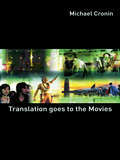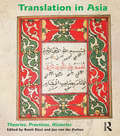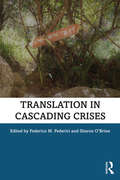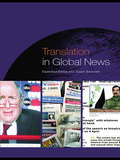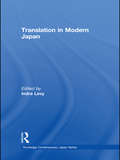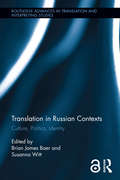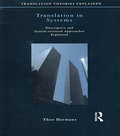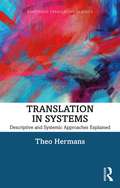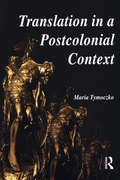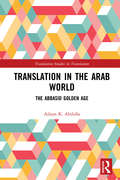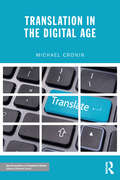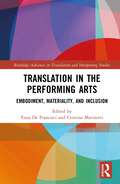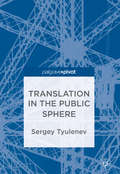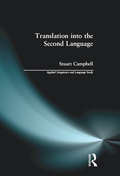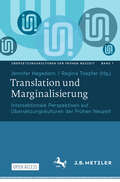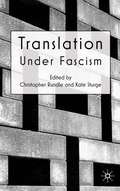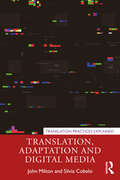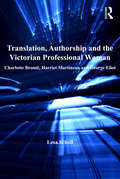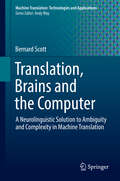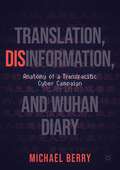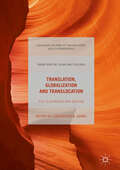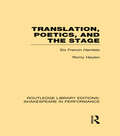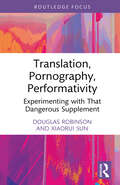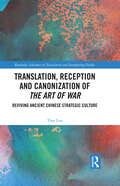- Table View
- List View
Translation goes to the Movies
by Michael CroninThis highly accessible introduction to translation theory, written by a leading author in the field, uses the genre of film to bring the main themes in translation to life. Through analyzing films as diverse as the Marx Brothers’ A Night at the Opera, The Star Wars Trilogies and Lost in Translation, the reader is encouraged to think about both issues and problems of translation as they are played out on the screen and issues of filmic representation through examining the translation dimension of specific films. In highlighting how translation has featured in both mainstream commercial and arthouse films over the years, Cronin shows how translation has been a concern of filmmakers dealing with questions of culture, identity, conflict and representation. This book is a lively and accessible text for translation theory courses and offers a new and largely unexplored approach to topics of identity and representation on screen. Translation Goes to the Movies will be of interest to those on translation studies and film studies courses.
Translation in Asia: Theories, Practices, Histories
by Ronit Ricci Jan van der PuttenThe field of translation studies was largely formed on the basis of modern Western notions of monolingual nations with print-literate societies and monochrome cultures. A significant number of societies in Asia – and their translation traditions – have diverged markedly from this model. With their often multilingual populations, and maintaining a highly oral orientation in the transmission of cultural knowledge, many Asian societies have sustained alternative notions of what ‘text’, ‘original’ and ‘translation’ may mean and have often emphasized ‘performance’ and ‘change’ rather than simple ‘copying’ or ‘transference’. The contributions in Translation in Asia present exciting new windows into South and Southeast Asian translation traditions and their vast array of shared, inter-connected and overlapping ideas about, and practices of translation, transmitted between these two regions over centuries of contact and exchange. Drawing on translation traditions rarely acknowledged within translation studies debates, including Tagalog, Tamil, Kannada, Malay, Hindi, Javanese, Telugu and Malayalam, the essays in this volume engage with myriad interactions of translation and religion, colonialism, and performance, and provide insight into alternative conceptualizations of translation across periods and locales. The understanding gained from these diverse perspectives will contribute to, complicate and expand the conversations unfolding in an emerging ‘international translation studies’.
Translation in Cascading Crises
by Sharon O'Brien Federico FedericiThis volume addresses the imperative need for recognizing, exploring, and developing the role of multilingual communication in crisis settings. It is recognized that 'communication is aid' and that access to communication is an undeniable human right in crises. Even where effective and accurate information is available to be distributed, circulated, and broadcast in different ways through an ever-growing array of technologies, too often the language barrier remains in place. From the Philippines to Lebanon via Spain, Italy, Columbia, and the UK, crisis situations occur worldwide, with different cultural reactions and needs everywhere. The contributors of this volume represent a geographical mixture of regions, language combinations, and disciplines, because crisis situations need to be studied in their locale with different methods. Drawing on disaster studies research, this book aims to stimulate a broad, multidisciplinary debate on how complex communication is in cascading crises and on the role translation can play to facilitate communication. Translation in Cascading Crises is a key resource for students and researchers of Translation and Interpreting Studies, Humanitarian Studies, and Disaster Studies.
Translation in Global News
by Susan Bassnett Esperanca BielsaThe mass media are of paramount importance in the formulation and transmission of messages about key developments of global significance, such as terrorism and the war in Iraq, yet the key mediating role of translation in the reception of speeches and addresses of figures like Osama Bin Laden and Saddam Hussein has remained largely invisible. Incorporating the results of extensive fieldwork in key global news organizations such as Reuters, Agence France Press and Inter Press Service, this book addresses central issues relating to the new pressures on translation arising from globalization, analyzing new texts from major news agencies as well as alternative media organizations. Co-written by Susan Bassnett, a leading figure in the field of translation studies, this book presents close readings of different English versions of key Arabic texts circulated in Western media to demonstrate the ways in which a cultural and religious 'Other' is framed in different media.
Translation in Modern Japan (Routledge Contemporary Japan Series)
by Indra LevyThe role of translation in the formation of modern Japanese identities has become one of the most exciting new fields of inquiry in Japanese studies. This book marks the first attempt to establish the contours of this new field, bringing together seminal works of Japanese scholarship and criticism with cutting-edge English-language scholarship. Collectively, the contributors to this book address two critical questions: 1) how does the conception of modern Japan as a culture of translation affect our understanding of Japanese modernity and its relation to the East/West divide? and 2) how does the example of a distinctly East Asian tradition of translation affect our understanding of translation itself? The chapter engage a wide array of disciplines, perspectives, and topics from politics to culture, the written language to visual culture, scientific discourse to children's literature and the Japanese conception of a national literature. Translation in Modern Japan will be of huge interest to a diverse readership in both Japanese studies and translation studies as well as students and scholars of the theory and practice of Japanese literary translation, traditional and modern Japanese history and culture, and Japanese women’s studies.
Translation in Russian Contexts: Culture, Politics, Identity (Routledge Advances in Translation and Interpreting Studies)
by Brian James Baer Susanna WittThis volume represents the first large-scale effort to address topics of translation in Russian contexts across the disciplinary boundaries of Slavic Studies and Translation Studies, thus opening up new perspectives for both fields. Leading scholars from Eastern and Western Europe offer a comprehensive overview of Russian translation history examining a variety of domains, including literature, philosophy and religion. Divided into three parts, this book highlights Russian contributions to translation theory and demonstrates how theoretical perspectives developed within the field help conceptualize relevant problems in cultural context in pre-Soviet, Soviet, and post-Soviet Russia. This transdisciplinary volume is a valuable addition to an under-researched area of translation studies and will appeal to a broad audience of scholars and students across the fields of Translation Studies, Slavic Studies, and Russian and Soviet history.
Translation in Systems: Descriptive and System-oriented Approaches Explained (Translation Theories Explored #Vol. 7)
by Theo HermansThe notion of systems has helped revolutionize translation studies since the 1970s. As a key part of many descriptive approaches, it has broken with the prescriptive focus on what translation should be, encouraging researchers to ask what translation does in specific cultural settings. From his privileged position as a direct participant in these developments, Theo Hermans explains how contemporary descriptive approaches came about, what the basic ideas were, and how those ideas have evolved over time. His discussion addresses the fundamental problems of translation norms, equivalence, polysystems and social systems, covering not only the work of Levý, Holmes, Even-Zohar, Toury, Lefevere, Lambert, Van Leuven-Zwart, Dhulst and others, but also giving special attention to recent contributions derived from Pierre Bourdieu and Niklas Luhmann. An added focus on practical questions of how to investigate translation (problems of definition, description, assessment of readerships, etc.) makes this book essential reading for graduate students and indeed any researchers in the field. Hermans' account of descriptive translation studies is both informed and critical. At the same time, he demonstrates the strength of the basic concepts, which have shown considerable vitality in their evolution and adaptation to the debates of the present day.
Translation in Systems: Descriptive and Systemic Approaches Explained (Routledge Translation Classics)
by Theo HermansA critically acclaimed foundational text, Translation in Systems offers a comprehensive guide to the descriptive and systemic approaches which have shaped translation studies. Theo Hermans considers translation norms, equivalence, polysystems and social systems, covering a wide range of theorists in his discussion of the principles of translation studies. Reissued with a new foreword by Kathryn Batchelor, which updates the text for a new generation of readers, Translation in Systems endures partly on account of Hermans’s vivid and articulate writing style. The book covers the fundamental problems of translation norms, equivalence, polysystems and social systems, encompassing not only the work of Levý, Holmes, Even-Zohar, Toury, Lefevere, Lambert, Bassnett, D'hulst and others, but also giving special attention to contributions derived from Pierre Bourdieu and Niklas Luhmann. Hermans explains how contemporary descriptive approaches came about, what the basic ideas were, how those ideas have evolved over time, and offers a critique of these approaches. With practical questions of how to investigate translation (including problems of definition, description and assessment of readerships), this is essential reading for graduate students and researchers in translation studies and related areas.
Translation in a Postcolonial Context: Early Irish Literature in English Translation
by Maria TymoczkoThis ground-breaking analysis of the cultural trajectory of England's first colony constitutes a major contribution to postcolonial studies, offering a template relevant to most cultures emerging from colonialism. At the same time, these Irish case studies become the means of interrogating contemporary theories of translation. Moving authoritatively between literary theory and linguistics, philosophy and cultural studies, anthropology and systems theory, the author provides a model for a much needed integrated approach to translation theory and practice. In the process, the work of a number of important literary translators is scrutinized, including such eminent and disparate figures as Standishn O'Grady, Augusta Gregory and Thomas Kinsella. The interdependence of the Irish translation movement and the work of the great 20th century writers of Ireland - including Yeats and Joyce - becomes clear, expressed for example in the symbiotic relationship that marks their approach to Irish formalism. Translation in a Postcolonial Context is essential reading for anyone interested in translation theory and practice, postcolonial studies, and Irish literature during the 19th and 20th centuries.
Translation in the Arab World: The Abbasid Golden Age (Translation Studies in Translation)
by Adnan K. AbdullaThe Translation Movement of the Abbasid Period, which lasted for almost three hundred years, was a unique event in world history. During this period, much of the intellectual tradition of the Greeks, Persians, and Indians was translated into Arabic—a language with no prior history of translation or of science, medicine, or philosophy. This book investigates the cultural and political conflicts that translation brought into the new Abbasid state from a sociological perspective, treating translation as a process and a product. The opening chapters outline the factors involved in the initiation and cessation of translational activity in the Abbasid period before dealing in individual chapters with important events in the Translation Movement, such as the translation of Aristotle’s Poetics into Arabic, Abdullah ibn al-Muqaffa’s seminal translation of the Indian/Persian Kalilah wa Dimna into Arabic and the translation of scientific texts. Other chapters address the question of whether the Abbasids had a theory of translation and why, despite three hundred years of translation, not a single poem was translated into Arabic. The final chapter deals with the influence of translation during this period on the Arabic language. Offering new readings of many issues that are associated with that period, informed by modern theories of translation, this is key reading for scholars and researchers in Translation Studies, Oriental and Arab Studies, Book History and Cultural History.
Translation in the Digital Age (New Perspectives in Translation and Interpreting Studies)
by Michael CroninTranslation is living through a period of revolutionary upheaval. The effects of digital technology and the internet on translation are continuous, widespread and profound. From automatic online translation services to the rise of crowdsourced translation and the proliferation of translation Apps for smartphones, the translation revolution is everywhere. The implications for human languages, cultures and society of this revolution are radical and far-reaching. In the Information Age that is the Translation Age, new ways of talking and thinking about translation which take full account of the dramatic changes in the digital sphere are urgently required. Michael Cronin examines the role of translation with regard to the debates around emerging digital technologies and analyses their social, cultural and political consequences, guiding readers through the beginnings of translation's engagement with technology, and through to the key issues that exist today. With links to many areas of study, Translation in the Digital Age is a vital read for students of modern languages, translation studies, cultural studies and applied linguistics.
Translation in the Performing Arts: Embodiment, Materiality, and Inclusion (Routledge Advances in Translation and Interpreting Studies)
by Enza De FrancisciThis innovative collection showcases the interconnectedness of translation and the performing arts, drawing on examples spanning languages, eras, and modes of performance to argue for the importance of re-envisioning translation beyond writing.Featuring contributions from established and emerging scholars, the volume builds on recent epistemological shifts from a genre-based view of translation toward a material-based approach interested in how performance and embodiment shape translation. Chapters highlight the ways in which, in the nexus of translation and performing arts, we can situate the cross-cultural encounters and transnational exchanges that underpin translation beyond the ideology of print, and help us to better understand the international circulation of performative works. The volume covers a wide range of embodied practices from immersive theatre and intercultural opera to dance and sign language performance, while also incorporating key perspectives from interviews with active practitioners. Taken together, the collection makes the case for a more nuanced understanding of translation, one which accounts for the relationships between translation and the myriad forms of performance that permeate daily life.This book will be of particular interest to students and scholars in translation studies, visual culture, theatre translation, performing arts, literary studies, media studies, and reception studies.
Translation in the Public Sphere
by Sergey TyulenevThis book brings together the study of translation with public sphere theory, in order to discuss social communication as it really happens. Through illuminating examples and case studies, translation is shown to be a mediating mechanism in all public debate conducted both within one society and between societies. The author offers a detailed discussion of the kinds of translation most relevant to public sphere communication and their properties. Throughout, he argues persuasively that it is impossible to study the public sphere without taking account of translation in it, and that the interaction between the public as a collective inevitably involves translation. Further, the author suggests new methodological approaches to studying not only translation in the public sphere but public debate itself as a kind of translation. Building on the achievements of both the public sphere scholarship and Translation Studies, this work fills a significant lacuna in existing literature and will set the agenda for future studies at the intersection of the two. It will provide an invaluable resource for scholars and students of the public sphere and translation, as well as academics in the broader fields of sociology, political science and communication.
Translation into the Second Language (Applied Linguistics and Language Study)
by Stuart CampbellThe dynamics of immigration, international commerce and the postcolonial world make it inevitable that much translation is done into a second language, despite the prevailing wisdom that translators should only work into their mother tongue. This book is the first study to explore the phenomenon of translation into a second language in a way that will interest applied linguists, translators and translation teachers, and ESOL teachers working with advanced level students. Rather than seeing translation into a second language as deficient output, this study adopts an interlanguage framework to consider L2 translation as the product of developing competence; learning to translate is seen as a special variety of second language acquisition. Through carefully worked case studies, separate components of translation competence are identified, among them the ability to create stylistically authentic texts in English, the ability to monitor and edit output, and the psychological attitudes that the translator brings to the task. While the case studies mainly deal with Arabic speakers undergoing translator training in Australia, the conclusions will have implications for translation into a second language, especially English, around the world. Translation into the Second Language is firmly grounded in empirical research, and in this regard it serves as a stimulus and a methodological guide for further research. It will be a valuable addition for advanced undergraduate and postgraduate students of applied linguistics, translation theory, bilingualism and second language acquisition as well as those involved in teaching or practicing translation at a professional level.
Translation on Display: Multilingual Texts in Multimodal Museum Space (Routledge Advances in Translation and Interpreting Studies)
by Min-Hsiu LiaoThis book foregrounds the role of translated texts in the study of the assemblages of semiotics resources in museums, important cultural institutions which encompass such sites as exhibition spaces, galleries, heritage sites, castles, and memorials.The book is organised in order of units of space, moving from smaller spaces to larger ones, with each chapter focused on an “act” enacted by the space, performed by the semiotic systems at work in these spaces and their visitors as social agents looking, feeling, moving, and living in them. In examining how translated texts interact with objects, spatial layout, surroundings, and visitors in the museum settings, the volume offers a way forward for better understanding the theoretical foundations of museum translation and the analytical tools available for examining textual data gathered from these spaces.This book will be of interest to scholars in translation studies, tourism studies, heritage studies, and cultural studies.
Translation und Marginalisierung: Intersektionale Perspektiven auf Übersetzungskulturen der Frühen Neuzeit (Übersetzungskulturen der Frühen Neuzeit #7)
by Regina Toepfer Jennifer HagedornÜbersetzungen spiegeln und bestätigen die Normen der zielkulturellen Mehrheitsgesellschaft und ihrer machthabenden Instanzen, wohingegen Anliegen von Minderheiten meist unberücksichtigt bleiben. Diesen oft übersehenen Zusammenhang zwischen Translation und Marginalisierung leuchtet der interdisziplinäre Open Access-Band für die Frühe Neuzeit systematisch aus und rückt jene Menschen, Figuren und Gruppen in den Mittelpunkt, die in doppelter oder mehrfacher Weise minderprivilegiert sind. In fünfzehn Kapiteln werden intersektionale Perspektiven auf die frühneuzeitlichen Übersetzungskulturen eröffnet und hierarchisierende Verfahren in Theorie, Praxis und Forschung offengelegt. Das Untersuchungsspektrum reicht von frühneuzeitlichen Übersetzungen antiker Epen und mittelalterlicher Kreuzzugsliteratur über frühneuzeitliche Reiseberichte aus Brasilien und dem Senegal bis hin zum rumänischen Kinder- und Jugendbuch und zur sogenannten Gipsy-Musik. Genderspezifische, heteronormative und koloniale Diskriminierungspraktiken sind verschränkt und verstärken sich wechselseitig. Translations reflect and affirm the norms of the target culture’s mainstream society and its power holders; the concerns of minorities, however, go largely unheeded. This interdisciplinary open-access volume illuminates the often-overlooked relationship between translation and marginalization while focusing on persons, characters, and groups that are underprivileged in two or more ways. Its fifteen chapters introduce intersectional perspectives on Early Modern translation cultures and shed light on hierarchizing processes in theory, practice, and research. The objects of study range from Early Modern translations of classical epic and medieval crusade literature and accounts of travel in Brazil and Senegal dating from the same period to Romanian children’s and juvenile literature and so-called gipsy music. Gender-specific, heteronormative, and colonial discrimination practices prove to intertwine and mutually amplify one another. Dies ist ein Open-Access-Buch.
Translation under Fascism
by Christopher Rundle Kate SturgeThe history of translation has focused on literary work but this book demonstrates the way in which political control can influence and be influenced by translation choices. New research and specially commissioned essays give access to existing research projects which at present are either scattered or unavailable in English.
Translation, Adaptation and Digital Media (Translation Practices Explained)
by John Milton Silvia CobeloAdaptation has always been central to Translation Studies, and, as print media becomes less and less dominant, and new media become central to communication, Adaptation is more than ever a vital area of Translation and Translation Studies. In addition, links to new digital media are examined. This is the only user-friendly textbook covering the full area of Translation, Adaptation, and Digital Media applicable to any language combination. Divided into nine chapters, it includes a wide range of texts from Brazilian culture, ensuring an ex-centric view of translation. Each chapter contains an expository section, case studies, and student activities to support learning. It emphasises the central role of Adaptation in the translation of works for the popular book market, for theatre, cinema, radio, and, especially, the new media. This is the essential textbook for students in Translation and Adaptation Studies courses and instructors and professionals working on adaptation and transmedia projects.
Translation, Authorship and the Victorian Professional Woman: Charlotte Brontë, Harriet Martineau and George Eliot
by Lesa SchollIn her study of Charlotte Brontë, Harriet Martineau and George Eliot, Lesa Scholl shows how three Victorian women writers broadened their capacity for literary professionalism by participating in translation and other conventionally derivative activities such as editing and reviewing early in their careers. In the nineteenth century, a move away from translating Greek and Latin Classical texts in favour of radical French and German philosophical works took place. As England colonised the globe, Continental philosophies penetrated English shores, causing fissures of faith, understanding and cultural stability. The influence of these new texts in England was unprecedented, and Eliot, Brontë and Martineau were instrumental in both literally and figuratively translating these ideas for their English audience. Each was transformed by access to foreign languages and cultures, first through the written word and then by travel to foreign locales, and the effects of this exposure manifest in their journalism, travel writing and fiction. Ultimately, Scholl argues, their study of foreign languages and their translation of foreign-language texts, nations and cultures enabled them to transgress the physical and ideological boundaries imposed by English middle-class conventions.
Translation, Brains and the Computer: A Neurolinguistic Solution to Ambiguity and Complexity in Machine Translation (Machine Translation: Technologies and Applications #2)
by Bernard ScottThis book is about machine translation (MT) and the classic problems associated with this language technology. It examines the causes of these problems and, for linguistic, rule-based systems, attributes the cause to language’s ambiguity and complexity and their interplay in logic-driven processes. For non-linguistic, data-driven systems, the book attributes translation shortcomings to the very lack of linguistics. It then proposes a demonstrable way to relieve these drawbacks in the shape of a working translation model (Logos Model) that has taken its inspiration from key assumptions about psycholinguistic and neurolinguistic function. The book suggests that this brain-based mechanism is effective precisely because it bridges both linguistically driven and data-driven methodologies. It shows how simulation of this cerebral mechanism has freed this one MT model from the all-important, classic problem of complexity when coping with the ambiguities of language. Logos Model accomplishes this by a data-driven process that does not sacrifice linguistic knowledge, but that, like the brain, integrates linguistics within a data-driven process. As a consequence, the book suggests that the brain-like mechanism embedded in this model has the potential to contribute to further advances in machine translation in all its technological instantiations.
Translation, Disinformation, and Wuhan Diary: Anatomy of a Transpacific Cyber Campaign
by Michael BerryDuring the early days of the COVID-19 health crisis, Fang Fang’s Wuhan Diary provided an important portal for people around the world to understand the outbreak, local response, and how the novel coronavirus was impacting everyday people. But when news of the international publication of Wuhan Diary appeared online in early April of 2020, Fang Fang’s writings became the target of a series of online attacks by “Chinese ultra-nationalists.” Over time, these attacks morphed into one of the most sophisticated and protracted hate Campaigns against a Chinese writer in decades. Meanwhile, as controversy around Wuhan Diary swelled in China, the author was transformed into a global icon, honored by the BBC as one of the most influential women of 2020 and featured in stories by dozens of international news outlets. This book, by the translator of Wuhan Diary into English, alternates between a first-hand account of the translation process and more critical observations on how a diary became a lightning rod for fierce political debate and the target of a sweeping online campaign that many described as a “cyber Cultural Revolution.” Eventually, even Berry would be pulled into the attacks and targeted by thousands of online trolls. This book answers the questions: why would an online lockdown diary elicit such a strong reaction among Chinese netizens? How did the controversy unfold and evolve? Who was behind it? And what can we learn from the “Fang Fang Incident” about contemporary Chinese politics and society? The book will be of interest to students and scholars of translation, as well as anyone with special interest in translation, US-Chinese relations, or internet culture more broadly.
Translation, Globalization and Translocation
by Concepción B. GodevThis book examines the spaces where translation and globalization intersect, whether they be classrooms, communities, or cultural texts. It foregrounds the connections between cultural analysis, literary critique, pedagogy and practice, uniting the disparate fields that operate within translation studies. In doing so, it offers fresh perspectives that will encourage the reader to reappraise translation studies as a field, reaffirming the directions that the subject has taken over the last twenty years. Offering a comprehensive analysis of the links between translation and globalization, this ambitious edited collection will appeal to students and scholars who work in any area of translation studies.
Translation, Poetics, and the Stage: Six French Hamlets (Routledge Library Editions: Shakespeare in Performance)
by Romy HeylenThis book establishes an analytical model for the description of existing translations in their historical context within a framework suggested by systemic concepts of literature. It argues against mainstream 20th-century translation theory and, by proposing a socio-cultural model of translation, takes into account how a translation functions in the receiving culture. The case studies of successive translations of "Hamlet" in France from the eighteenth century neoclassical version of Jean-Francois Ducis to the 20th-century Lacanian, post-structuralist stage production of Daniel Mesguich show the translator at work. Each chapter focuses on a different aspect of the changing theatrical and literary norms to which translators through the ages have been bound by the expectations both of their audiences and the literary establishment.
Translation, Pornography, Performativity: Experimenting with That Dangerous Supplement (Routledge Advances in Translation and Interpreting Studies)
by Douglas Robinson Xiaorui SunRobinson and Sun’s book goes in search of the neglected metaphorics of translation in pornography using poststructuralist rethinkings and reframings of porn (and masturbation) from Jacques Derrida to Judith Butler.In his 1684 “Essay on Translated Verse,” the Earl of Roscommon attacked “want of decency” in translation metaphorically by comparing it to picking up prostitutes in the park (“raking the park for stews”) instead of hanging out with “troops of faultless nymphs.” Sex work, and the graphic representation of sex work that Nathaniel Butler was the first to call “pornography” in print in 1638, is used as a metaphor for non-normative translation, which in Robinson and Sun’s hands becomes experimental translation.En route to that goal, the authors take us through Butler on performativity and resistance, Derrida on supplementarity and iterability, and Haun Saussy’s innovative application of Derridean citationality to the use of a target-cultural “sponsor” or “bondsman” for translation. They take detours through Charles Baudelaire’s “Une charogne” and J.G. Ballard’s “The Drowned Giant.”They deal with the performativity of pornography (and translatography) in Part I, the “unnatural” iterability of masturbation (and translation) in Part II, and experimental translation in Part III.The theory-littered path this book takes through the metaphorics of translation will be of interest to scholars and students of translation studies, especially experimental translation and translation theory, but also media scholars interested in the philosophical complexities of performativity.
Translation, Reception and Canonization of The Art of War: Reviving Ancient Chinese Strategic Culture (Routledge Advances in Translation and Interpreting Studies)
by Tian LuoThe Art of War by Sun Tzu is an ancient yet invaluable Chinese military classic that is still relevant today. This book presents a systematic and in-depth investigation into the translation and reception of The Art of War in the western strategic culture. Aided by three self-built corpora, this study adopts a mixed method including both qualitative and quantitative analysis, and aking takes both the core text and its paratexts of The Art of War into consideration. This study highlights the significance of proper approaches to translating culture in the core text and effective measures of culture reconstruction in paratexts. It is revealed that the translated Sun Tzu has undergone three major stages before it is gradually welcomed and re-canonized in western discourse. The findings bring into light the multiple factors that contribute to the incorporation of Sun Tzu’s strategic wisdom into western culture. For scholars interested in translation studies, (critical) discourse analysis as well as strategic studies, this book provides fresh insights and new perspectives.
